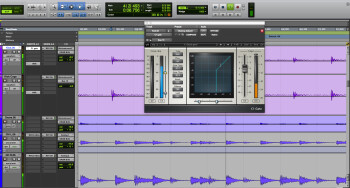Up to now we have only seen the more typical uses of a Noise Gate. Now we'll start looking into less obvious techniques that can make a gate much more interesting during mixdown.
Punchy booster
In a previous article I talked about the use of a compressor to give more punch to a recording. But a compressor is not the only means of providing sound with this type of energy. Indeed, a noise gate can also play the part. Which is pretty logical if you think of it.
A brief reminder for those of you who might be a bit lost: A sound is perceived as “punchy” when the attack of a signal is predominant over its decay. And what does a noise gate do? It attenuates the volume of a signal below a given threshold, while leaving intact the rest of the signal. Hence, to achieve the expected result, you only need to set the threshold of the gate right above the natural decay of a sound. The Range parameter will allow you to adjust the difference between the signal’s attack and decay, which determines the amount of punch. The Release time, together with the Hold parameter, will help you redesign the natural decay of the processed signal, so you can control everything even more precisely.
It’s important to note that this technique is used mainly on percussive instruments. However, it can work wonders on any other element that has a solid beat, especially rhythm guitars or bass tracks recorded with a DI box.
Do note, however, that you shouldn’t go to extremes with the Range parameter, in order for the result to remain relatively natural.
Finally, if the transients seems to be having a hard time due to the gate, the Look-ahead function will allow you to round things off. In this regard, here’s a little trick that will surely interest you if your gate doesn’t have this facility. It’s very easy to create a virtual Look-ahead, as long your gate has an external sidechain. Take, for example, a kick drum track. Start by duplicating the track and making sure you don’t send the copy to the master bus. Now, insert the noise gate on the original track and feed its sidechain with the duplicate. By shifting the signal of the copy several milliseconds, you’ll get the equivalent of a look-ahead but with much more flexibility, since you can determine more precisely the leading time the gate will have on the processed signal. There are no rules regarding the look-ahead time, so it’s up to your ears to decide. However, generally speaking, a shift of 1ms to 20 ms ought to be more than enough. This trick works just as well with software as with hardware noise gates.
Next week we’ll see how to use a noise gate to rebalance a deficient overhead track.

